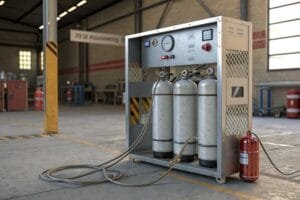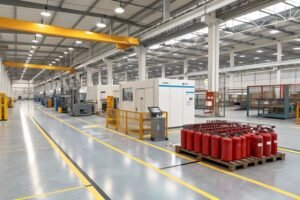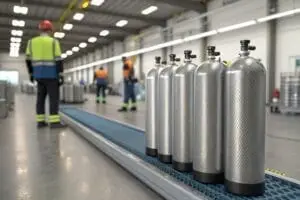Confusing medical oxygen tanks with scuba tanks is a common but risky mistake. The consequences of using the wrong cylinder can be severe for both your business and your customers.
Simply put, you can never use a scuba tank for medical oxygen, or vice versa. The gas purity, cylinder materials, pressure ratings, and valve connections are completely different and specifically designed for their intended use. Mixing them up is incredibly dangerous and violates safety regulations.
As a manufacturer of high-pressure gas cylinders for over a decade, I've seen a lot. I've spoken with hundreds of buyers, from diving equipment wholesalers in Australia to medical distributors in the Middle East. One question that comes up more often than you'd think is about the interchangeability of these two types of cylinders. It's an understandable question from a logistics point of view, but a dangerous one from a safety perspective. The answer is always a firm "no." In this article, I want to walk you through exactly why. Understanding these key differences isn't just about technical knowledge; it's about protecting your customers, your reputation, and your business. Let's dive in.
Are the purity standards for medical-grade oxygen and diving air different?
Thinking "air is air" is a simple oversight with major safety implications. This assumption ignores the strict purity standards that govern gases meant for breathing in different environments.
Yes, the standards are drastically different. Medical oxygen is required to be at least 99% pure oxygen. Scuba tanks, on the other hand, are filled with compressed atmospheric air, which is only about 21% oxygen and 78% nitrogen. These are not interchangeable.
I remember a conversation with a new distributor, let's call him David. He was starting a new venture that included both a dive shop and a small medical equipment rental service. He asked, "To be efficient, can I just use one type of gas for both?" It was a logical business question, but I had to immediately explain the critical safety differences. We spent the next hour on a call discussing gas compositions. That conversation is why I believe it's so important for us, as manufacturers, to educate our partners. The difference isn't small; it's the core of why these products are separate.
Medical-Grade Oxygen vs. Breathing Air
The fundamental difference lies in the gas composition and its purpose.
- Medical-Grade Oxygen: This gas is classified as a drug by the FDA and other international bodies. Its primary purpose is for therapeutic use, such as helping a patient with respiratory issues breathe. It must meet United States Pharmacopeia (USP) standards, which mandate a purity of 99.0% - 99.5% pure oxygen. Impurities are strictly limited because they could harm a medically fragile person.
- SCUBA Breathing Air: The air in a scuba tank is simply filtered atmospheric air compressed to high pressure. It must meet standards like CGA Grade E. The goal here is to replicate the air we naturally breathe, just in an underwater environment. Breathing pure oxygen at the depths and pressures common in scuba diving can cause acute oxygen toxicity, leading to convulsions, blackouts, and drowning.
Here is a simple table to show the difference:
| Component | Medical-Grade Oxygen (USP) | SCUBA Breathing Air (Grade E) |
|---|---|---|
| Oxygen ($O_2$) | 99.0% minimum | 20% - 22% |
| Nitrogen ($N_2$) | N/A | ~78% |
| Carbon Monoxide (CO) | < 10 ppm | < 10 ppm |
| Carbon Dioxide ($CO_2$) | < 300 ppm | < 500 ppm |
| Moisture | Very low | Very low |
What are the key distinctions in cylinder material, design, and pressure ratings?
Assuming all high-pressure cylinders are built the same is a trap. The material and design of a tank are carefully chosen for its specific job, affecting its weight, durability, and safety limits.
Medical and scuba cylinders are made from different materials and have different pressure ratings. Medical tanks prioritize being lightweight for portability. Scuba tanks prioritize strength and corrosion resistance for high-pressure, underwater use. Their designs are not the same.
When we design a new cylinder line, the first question is always: "What is its purpose?" A cylinder destined for an ambulance has very different needs than one going 100 feet underwater. For example, our medical cylinders often use a specific lightweight aluminum alloy. Portability is key. But for our carbon fiber scuba tanks, the focus is on achieving very high pressure ratings while keeping the weight manageable for the diver. The materials and the manufacturing process are tailored for these completely different scenarios. You can't just switch them.
A Closer Look at Cylinder Construction
The demands of the medical field and the scuba diving world have led to distinct choices in cylinder engineering.
Materials
- Medical Cylinders: Often made from steel (like 3AA) for durability in high-use environments or, more commonly, a lightweight aluminum alloy (
aluminum cylinder) like 6061. The goal is to make them easy for patients or paramedics to carry. - SCUBA Cylinders: The classic
aluminum scuba cylinderis made from 6061 alloy, but it's built with thicker walls to handle higher pressures and physical abuse. Steel tanks are also used for their durability. More advancedcarbon fiber dive cylinderswrap a thin aluminum liner with carbon fiber, allowing for much higher pressures (up to 4500 PSI / 300 BAR) at a lower weight than steel.
Pressure Ratings
A cylinder's service pressure is the maximum pressure it should be filled to. This is one of the most critical safety markings.
- Medical Cylinders: Typically have a service pressure around 2015 - 2216 PSI (139 - 153 BAR).
- SCUBA Cylinders: Standard aluminum tanks are rated to 3000 PSI (207 BAR), with some high-pressure steel and all
carbon fiber composite gas cylindersrated to 4500 PSI (300 BAR) or more. Filling a medical cylinder to scuba pressures would cause it to fail catastrophically.
| Feature | Typical Medical Cylinder (M6 Size) | Typical SCUBA Cylinder (AL80) |
|---|---|---|
| Primary Material | Lightweight Aluminum Alloy | 6061 Aluminum Alloy |
| Typical Use | Oxygen therapy, emergency response | Recreational Diving |
| Service Pressure | ~2216 PSI / 153 BAR | ~3000 PSI / 207 BAR |
| Design Focus | Portability and low weight | Durability & corrosion resistance |
Why can't the valves and regulators be used interchangeably?
You might think you can just swap the fittings, but this is impossible by design. The valve is the gateway to the cylinder, and it’s built to be a lock that only the right key can open.
Valves and regulators for medical oxygen and scuba are intentionally designed to be incompatible. This is a critical safety feature to prevent you from connecting the wrong gas supply to the wrong equipment, which could cause equipment failure or a fire.
This is a non-negotiable safety standard in our industry. Every cylinder manufacturer must use specific, standardized connections for different gases. For medical oxygen in the US, the standard is the CGA 540 connection. For scuba, it's the Yoke (A-clamp) or DIN system. They physically will not connect to each other. We machine our valves to precise tolerances to ensure this system works perfectly. It's a simple, mechanical way to prevent a potentially fatal mistake.
A System Designed for Safety
The connection systems are the most visible difference and are built to be foolproof.
Medical Valve Systems
- CGA and Pin-Index: In North America, large medical oxygen cylinders use a CGA (Compressed Gas Association) valve, like the CGA 540. Smaller cylinders use the Pin-Index Safety System (PISS). This system uses a specific pattern of pins on the valve that must align with holes on the regulator. The pin pattern for oxygen is different from the pattern for nitrogen, air, or any other medical gas. This makes it physically impossible to attach an oxygen regulator to a nitrogen tank.
SCUBA Valve Systems
- Yoke (A-Clamp): This is the most common system in recreational diving, especially in North America and the tropics. A regulator fits over the valve and is secured by a clamp. It's simple and robust.
- DIN (Deutsches Institut für Normung): This system is more common in Europe and technical diving. The regulator screws directly into the valve. DIN systems can handle higher pressures than Yoke systems, which is why they are standard on all
high pressure gas cylindersrated above 3000 PSI.
The bottom line is that you cannot physically connect a scuba regulator to a medical oxygen tank, or vice versa. This isn't an inconvenience; it's a life-saving feature. Furthermore, pure oxygen under high pressure is highly reactive. The internal components of a scuba regulator (like certain O-rings) are not always made from oxygen-compatible materials and could ignite if exposed to pure, high-pressure O2.
How do manufacturing regulations and testing standards compare?
Sourcing cylinders without understanding the rules is a major business risk. Regulations aren't just red tape; they are a guarantee of quality and safety that protects everyone in the supply chain.
Both cylinder types are highly regulated, but they follow different paths. They must meet strict standards from bodies like the DOT (US) or ISO. These rules cover manufacturing, materials, markings, and mandatory re-testing schedules to ensure continued safety.
As a factory with five production lines, compliance is at the center of everything we do. We export to North America, the Middle East, and Southeast Asia, so our cylinders have to meet multiple international standards. When a buyer like David from Australia asks about quality, he's also asking about compliance. He needs to know the cylinders he imports are legal and safe. Providing a cylinder with clear, correct markings and a recent test date is part of our commitment to quality.
Decoding the Markings and Tests
Every high pressure cylinder is legally required to be stamped with important information. Understanding these markings is crucial for any distributor or wholesaler.
Key Markings to Look For:
- Specification: This indicates the manufacturing standard, such as
DOT-3ALfor a US-made aluminum cylinder or anISOnumber for international standards. - Service Pressure: The maximum fill pressure in PSI or BAR.
- Serial Number: A unique identifier for the cylinder.
- Manufacturer's Mark: The symbol of the company that made it, like our
Snowrainbrand mark. - Test Dates: The date of the initial qualification test and any subsequent re-tests.
Hydrostatic Testing
This is the most important part of cylinder maintenance. The cylinder is filled with water and pressurized to a specific test pressure (usually 5/3 of its service pressure) to check for expansion and leaks.
- SCUBA Cylinders (US): Typically require hydrostatic testing every 5 years.
- Medical Cylinders (US): Testing schedules can vary based on material and use, but are often also in the 5 to 10-year range.
Selling or filling a cylinder that is out of its test date is illegal and unsafe. As a distributor, checking these dates on your inventory is a critical part of your safety protocol. It’s a responsibility we all share in the industry.
Conclusion
Medical oxygen and scuba cylinders are not interchangeable. They are specialized tools with different gases, materials, valves, and regulations. Sourcing from an expert manufacturer ensures you get the right, safe product every time.







